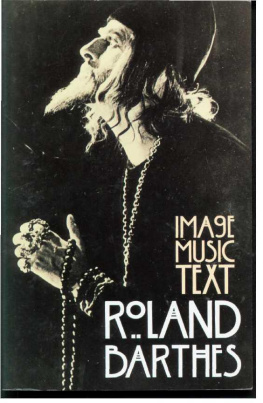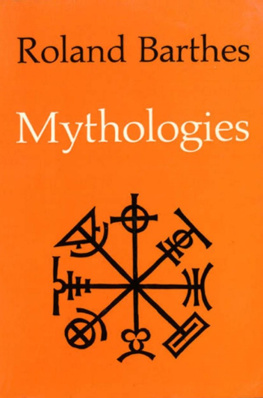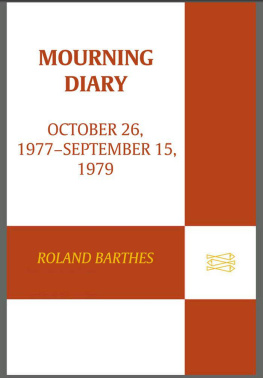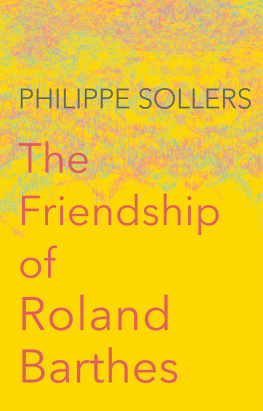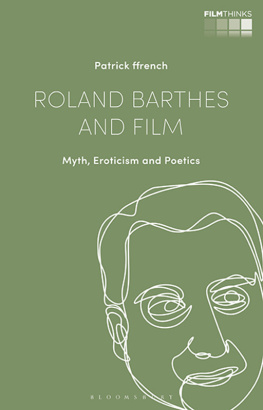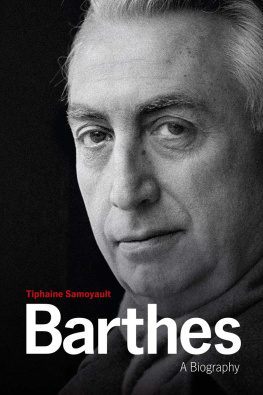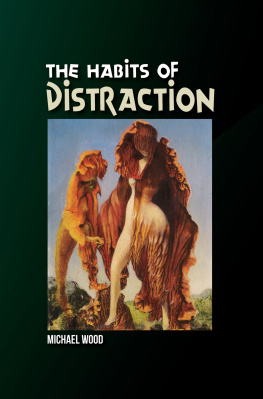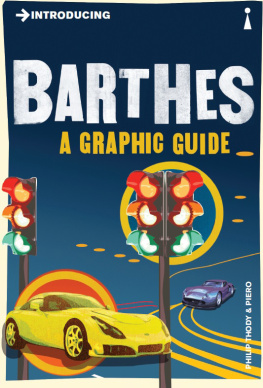
I M A G E M U S I C T E X T
ROLAND BARTHES was bom in 1915 and died in 1980. At
the time of his death he was Professor at the College de
France. Among his books are Le Degre zero de I'ecriture
(1953), Mythologies (1957), Elements de semiologie (1964),
S/Z (1970), L'Empire des signes (1970), Sade, Fourier, Loyola
(1971), Roland Barthes par Roland Barthes (1975), Fragments
d'un discours amoureux (1977), and La Chambre claire (1980).
STEPHEN HEATH is a Fellow ofJesus College and Reader in
Cultural Studies in the University of Cambridge. His books
include a study of Barthes, Vertige du deplacement (1974),
and, most recently, Gustave Flaubert: 'Madame Bovary'(\992).

R O L A N D BARTHES
Image Music Text
Essays selected and translated
by Stephen Heath
FontanaPress
An Imprint of HarperCollinsPublishers

Fontana Press
An imprint of HarperCollinsPublishers
77-85 Fulham Palace Road
Hammersmith, London, w6 8JB
www.fireandwater.com
Published by Fontana Press 1977
Copyright Roland Barthes 1977
English translation copyright Stephen Heath 1977
Illustrations I, XI, XII, XIII, XIV and XV
are from the collection of Vincent Pinel
ISBN 0 00 686135 0
Set in Times
Printed in Great Britain by
Clays Ltd, St Ives plc
All rights reserved. No part of this publication may be
reproduced, stored in a retrieval system, or transmitted,
in any form or by any means, electronic, mechanical,
photocopying, recording or otherwise, without the prior
permission of the publishers.
This book is sold subject to the condition that it shall not,
by way of trade or otherwise, be lent, re-sold, hired out or
otherwise circulated without the publisher's prior
consent in any form of binding or cover other than that in which
it is published and without a similar condition including this
condition being imposed on the subsequent purchaser.

Contents
Translator's Note 7
Sources 13
The Photographic Message 15
Rhetoric of the Image 32
The Third Meaning 52
Research notes on some Eisenstein stills
Diderot, Brecht, Eisenstein 69
Introduction to the Structural Analysis of Narratives 79
The Struggle with the Angel 125
Textual analysis of Genesis 32: 22-32
The Death of the Author 142
Musica Practica 149
From Work to Text 155
Change the Object Itself 165
Mythology today
Lesson in Writing 170
The Grain of the Voice 179
Writers, Intellectuals, Teachers 190
Index 217

Translator's Note
Leaving aside the problems involved in any translation,
special difficulties arise when (as here) there is (as yet?)
no real overlap in theoretical context between the two
languages in question. With regard to the semiological
reference in these essays, I have tried wherever possible to
conform to the terminological solutions adopted by the
English translators of Barthes's Elements of Semiology. A
certain amount of bibliographical - and occasionally
explanatory - material has been added in footnotes which
are identified by being placed in square brackets.
The following terms pose particular difficulties:
Langue|parole - The reference here is to the distinction
made by the Swiss linguist Saussure. Where parole is the
realm of the individual moments of language use, of parti
cular 'utterances' or 'messages', whether spoken or written,
langue is the system or code ('le code de la langue') which
allows the realization of the individual messages. As the
language-system, object of linguistics, langue is thus also
to be differentiated from langage, the heterogeneous totality
with which the linguist is initially faced and which may be
studied from a variety of points of view, partaking as it
does of the physical, the physiological, the mental, the
individual and the social. It is precisely by delimiting its
specific object and fixing as its task the description of that
object (that is, of the langue, the system of the language)
that Saussure founds linguistics as a science. (Chomsky's
distinction between competence/performance - 'the speaker
hearer's knowledge of his language' and 'the actual use of

8 | IMAGE - MUSIC - TEXT
language in concrete situations' - resembles that between
langue|parole but, so to speak, brings within the scope of
langue elements - the recursive processes underlying
sentence formation - regarded by Saussure as belonging
to parole). The problem in translation is that in English
'language' has to serve for both langue and langage. Langue
can often be specified by translation as 'a' or 'the language'
or again as 'language-system' (in opposition to the 'language
use' of parole), but I have included the French term in
brackets in cases where the idea of the analytic construction
of a language-system is being given crucial stress (see notably
the 'Introduction to the structural analysis of narratives').
Enonce|enonciation - Both these terms are often translated
in English as 'utterance', but whereas the first signifies what
is uttered (the statement, the proposition), the second
signifies the act of uttering (the act of speech, writing or
whatever by which the statement is stated, the proposition
proposed). This distinction rejoins and displaces that
between langue/parole: every enonce is a piece of parole;
consideration of e nonciation involves not only the social
and psychological (i.e. non-linguistic) context of enonces,
but also features of langue itself, of the ways in which it
structures the possibilities of e nonciation (symbol-indexes
such as personal pronouns, tenses, anaphores are the most
obvious of these linguistic features of e nonciation). The
distinction - the displacement - has particular importance
in any - semiological, psychoanalytical, textual - attention
to the passage, the divisions, of the subject in language,
in the symbolic, to the slide seized in the disjunction of
the sujet de I'enonce and the sujet de l'enonciation. In the
utterance 'I am lying', for example, it is evident that the
subject of the proposition is not one with the subject of
the enunciation of the proposition - the 'I' cannot lie on

